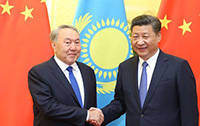Tourist influx on way as visa hassles cut
By SU ZHOU (China Daily) Updated: 2016-05-26 16:02Chinese travel agencies predict stellar growth in the number of Chinese tourists visiting Australia as a result of the country's trial of 10-year multiple-entry tourist visas for Chinese.
Because of Australia's onerous visa conditions and process it has been missing from the list of most sought-after tourist destinations by Chinese, says Ctrip, one of China's leading online travel agents.
"Australia can boast of a host of natural attractions, making it a great choice for experienced travelers," said Yan Xin, Ctrip's publicity manager. "However, visa barriers have prevented many Chinese tourists from visiting this haven for outdoor enthusiasts. Visa-free or visa-on-arrival destinations are more popular."
When Australia's Prime Minister, Malcolm Turnbull, was in China recently he announced that the country would make it easier for Chinese tourists to apply for visas, taking applications online and in Chinese and trialing visas that would be valid for 10 years.
The country also introduced new virtual tourism technology for mobile devices in April. The mobile applications connect to social media to enable viewers the so-called virtual experience of visiting Australia. It is designed to "make Australia more accessible, more available, more compelling as a tourism destination", Australian tourism authorities say.
Though many Chinese have been reticent to visit Australia because of the visa hassles, they are the fastest growing group of tourists to the country and the most valuable. Last year Chinese tourists paid 1 million visits to Australia and spent about 35.5 billion yuan ($7.5 billion) in the country, helping Australia achieve a 10-year target it had set for itself in half the time.
Chinese spending on tourism accounted for 6 percent of growth in the Australian economy last year, Tourism Australia says.
U-tour International Travel Service of Beijing said that to the end of November the number of Chinese booking trips to Australia through it rose 50 percent year on year.
Ctrip said the number of tourism trips to Australia that Chinese booked through it last year rose 120 percent compared with the previous year. During China's Spring Festival (celebrated around the Chinese New Year) this year, bookings for Australia were double what they were the previous year.
"A lot of wealthy families enjoy spending Chinese New Year in Australia with their children," Mr Yan of Ctrip said.
"Wilderness, plants, animals, local cuisine and wine is a perfect combination for family trips."
Yet the market potential is far from tapped, said Margy Osmond, chief executive of the Tourism and Transport Forum.
"Australia's share of the Chinese tourism market represents less than 1 percent of the 100 million Chinese traveling overseas," the Gold Coast Bulletin quoted her as saying.
Many travel agencies expect more and more Chinese to opt for more independent holidays that include, for example, rental cars and adventure trips and study tours.
At present tourism products in Australia take in all kinds of outdoor sports, including skiing, golf, hiking, diving, fishing and cycling, Mr Yan said.
"More and more Chinese travelers are also choosing to plan their own trips in Australia and rent cars. These experienced travelers are likely to choose less-known destinations. Among these people Whitsunday Island, the Blue Mountains, rainforest tours out of Cairns, Uluru, Adelaide and Kangaroo Island are popular."




